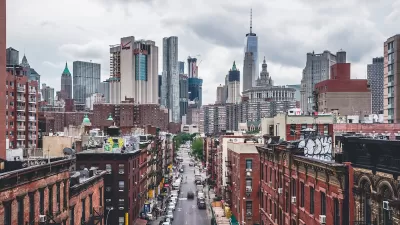Haya El Nasser and Paul Overberg report on how current trends could cause the extinction of suburban sprawl.
As recent census data, and a fascinating interactive map accompanying the article, illustrate, the economic downturn, rising gas prices and high unemployment rates have substantially affected how Americans consider where they live, with cities and older suburbs coming out ahead.
"This could be the end of the exurb as a place where people aspire to go when they're starting their families," says William Frey, demographer at the Brookings Institution. "So many people have been burned by this... First-time home buyers, immigrants and minorities took a real big hit."
The past five years have already witnessed a sizable shift toward greater population growth in metro and urban areas and away from the long commutes of suburbia. And according to John McIlwain, senior fellow for housing at the Urban Land Institute, this trend may have legs: "Aging Baby Boomers, who have begun to retire, and Millennials, who are mostly in their teens and 20s, are more inclined to live in urban areas."
However, as El Nasser and Overberg note, "During the '70s gas shortage and the '80s savings and loan industry crisis, some predicted the end of suburban sprawl." Only time will tell if suburban sprawl will live to die another day.
FULL STORY: America's romance with sprawl may be over

Alabama: Trump Terminates Settlements for Black Communities Harmed By Raw Sewage
Trump deemed the landmark civil rights agreement “illegal DEI and environmental justice policy.”

Study: Maui’s Plan to Convert Vacation Rentals to Long-Term Housing Could Cause Nearly $1 Billion Economic Loss
The plan would reduce visitor accommodation by 25% resulting in 1,900 jobs lost.

Planetizen Federal Action Tracker
A weekly monitor of how Trump’s orders and actions are impacting planners and planning in America.

Wind Energy on the Rise Despite Federal Policy Reversal
The Trump administration is revoking federal support for renewable energy, but demand for new projects continues unabated.

Passengers Flock to Caltrain After Electrification
The new electric trains are running faster and more reliably, leading to strong ridership growth on the Bay Area rail system.

Texas Churches Rally Behind ‘Yes in God’s Back Yard’ Legislation
Religious leaders want the state to reduce zoning regulations to streamline leasing church-owned land to housing developers.
Urban Design for Planners 1: Software Tools
This six-course series explores essential urban design concepts using open source software and equips planners with the tools they need to participate fully in the urban design process.
Planning for Universal Design
Learn the tools for implementing Universal Design in planning regulations.
Caltrans
Smith Gee Studio
Institute for Housing and Urban Development Studies (IHS)
City of Grandview
Harvard GSD Executive Education
Toledo-Lucas County Plan Commissions
Salt Lake City
NYU Wagner Graduate School of Public Service





























